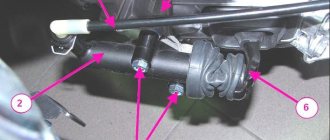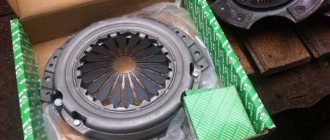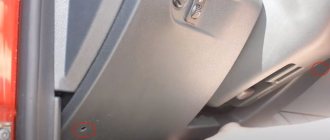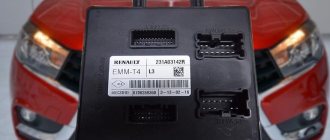With a working engine, an impeccable gearbox, and a new chassis, the car will not go anywhere without a clutch. On the Lada Vesta this is one of the most important components. The task of a mechanical clutch is to connect the internal combustion engine and manual transmission, transmitting torque from the engine to the chassis, and also to separate them when changing gears (if you leave the gearbox input shaft rotating through the internal combustion engine, the gears will inevitably be damaged).
The Lada Vesta clutch on a manual transmission (mechanical) consists of one disc, engagement is made mechanically (dry, permanently closed type), the drive is hydraulic. The latter means that the unit is driven by fluid pressure and is adjusted manually (by foot) by the driver. In addition, the fluid system acts as a pedal booster. After all, simply pressing with your foot is not enough to set in motion the structure, which engages with the shaft while rotating several thousand revolutions. Therefore, there is no need for hydraulics on an AMT. Read the article to the end and you will learn the intricacies of this knot! Find out the problems that often happen and the clutch drive fails: the release bearing or the basket as a whole is broken. It's time to change, or adjust enough, precise adjustment is important for good operation of the unit. Replacement at the dealer at 9 TO.
Clutch replacement on Lada Vesta cars under warranty
You can replace the clutch on a Lada Vesta under warranty. A similar procedure can be carried out when the car breaks down during the first 20,000 kilometers. If it is proven that neither the driver nor third-party manipulations are involved in the malfunction of the unit, the service center will carry out repairs free of charge. After the replacement, the brakes will also be bled. This is a mandatory process for a hydraulic drive, since after the intervention air cavities (plugs) are formed in the system. For a robotic gearbox, another manipulation is carried out - adaptation.
Under warranty: replacement of the clutch mechanism is also included in the list of TO9 works for the Lada Vesta. Even if the unit is working, it will have to be replaced. There is no need to worry about this; the life of the part has come to an end anyway, and it will not last long.
Clutch faults
Vesta, depending on the type of transmission, may have a different drive. Accordingly, their problems may be different.
Problems with the hydraulic clutch
The brake fluid enters the working cylinder from the master cylinder through pipelines. The following malfunctions occur with these two main parts of the mechanism:
- excessive wear of rubber cuffs in cylinders;
- brake fluid leakage (lack of tightness at the pipe connections);
- damage to cylinders, pipelines, etc., which causes cracks to appear.
The hydraulic drive is highly reliable, but it can also fail if air gets into the system. The main sign of airing: incomplete disengagement of the clutch. Because of this, the gears will either be switched on with great difficulty or will be almost impossible to do. Typically, air enters the system when the level of brake fluid in the master cylinder reservoir is critically low, or due to loss of tightness. To troubleshoot problems, it is enough to bleed the system; a special fitting is provided for this.
There is no need to adjust the hydraulic clutch drive while the vehicle is in use.
The durability of the system depends on the driving style of the owner and operating conditions. A working clutch will not slip and fully transmit torque from the engine to the gearbox when the pedal is released. When the pedal is depressed, the transmission must be completely disconnected from the power plant.
You can check the performance of the hydraulic drive of the Lada Vesta manual transmission yourself, following a certain algorithm.
Clutch adjustment on Lada Vesta cars
Since the knot is constantly engaged/disengaged, it needs fine adjustment. Adjustments are made on site during installation. The driven disk is centered, the basket, and the release bearing are also centered - they must fit exactly into the splines of the flywheel and the input shaft of the gearbox.
In the future, you can adjust the position of the clutch cable so that the pedal is softer/harder, so that it responds better to the command (during operation, the cable may stretch).
On a Lada with a robotic gearbox, the clutch is regulated by special programs. Adaptation can only be completed at an official dealer. However, the service life of the AMT clutch is significantly longer than that of a manual transmission.
Clutch device
On the Lada Vesta, as well as on all its modifications, including the X-RAY crossover and Cross versions, a standard unit with one disk is installed. The contact of the friction and drive disk occurs under the action of a spring. The main difference between the Vesta clutch and other AvtoVAZ models is the drive.
A hydraulic drive is installed on the mechanics, and an electromechanical drive on the robot.
Structurally, the Vesta clutch is designed according to the standard type and consists of a pressure and driven disc that interact with each other. A pressure disk is installed in the basket; the basket itself is a steel body. The pressure plate in the basket is pressed using a special device in the form of a spring. The clutch basket is installed directly on the flywheel of the power unit and is firmly attached to bolted connections.
A disc with friction linings is placed between the flywheel and the drive disc. The driven clutch disc is also called a friction disc due to special linings attached to both sides. A damper with springs is installed in the center of the hole, designed to eliminate vibrations when the clutch is engaged. The friction disc is mounted through the hub onto the engine input shaft.
Features of the Vesta clutch hydraulic drive
The hydraulic drive consists of pipelines and two cylinders (worker and main). From the master cylinder, the pressure from the rod is transferred to the working one. This, in turn, exerts an influence on the clamping device through pipelines. The working cylinder is a module where the release bearing is also located. All this is mounted in the clutch housing.
Brake fluid performs the functions of working fluid. To ensure the reliability and performance of the hydraulic drive, it is necessary to promptly change the working fluid in accordance with the regulations. Problems with the hydraulic drive most often result from air in the system. In advanced cases, it will simply be impossible to change gears on the car.
Features of the electric clutch drive on Vesta
The electric drive, unlike the hydraulic one, is designed slightly differently; it acts directly on the clutch fork. When the fork is turned, the force puts pressure on the release bearing, which, in turn, presses on the petals of the pressure plate spring. The release bearing is reinforced and is constantly in operation, and the spring is always pressed against the coupling due to the absence of any gaps.
The release bearing does not require periodic maintenance, i.e. no lubrication is needed, the manufacturer took care of this too. The bearing lasts a long time and is simply replaced if it fails. You can recognize this by the characteristic noise. The release plate must also be replaced when replacing the driven or pressure disks, regardless of whether the bearing is in good condition or not.
Malfunctions in the operation of the hydraulic drive can be easily eliminated with your own hands; often it is enough to bleed the system and get rid of the air. But with an electromechanical drive, troubleshooting is much more complicated. A similar procedure on automatic and robotic gearboxes is called adaptation, and it is impossible to perform it without knowledge, skills and equipment. In such cases, the only correct decision is to contact an official dealer.
Today, the AvtoVAZ plant is actively introducing modern technologies into its cars, this also applies to clutches. Nowadays, structural elements that meet international quality standards are used for this. Friction linings and springs are much more reliable and durable.
The introduction of modern technologies and materials makes it possible to ensure a soft start and make gear shifts clearer and smoother.
Analogs
The manufacturers themselves recommend 826818 VALEO 2180 for Vesta. Owners note that when using the model, the pedal becomes noticeably softer and the car starts easily. The note applies to the original set; fakes are often found. The spare part costs four thousand eight hundred rubles.
The original part of the Lada Vesta is not suitable for the 21129 engine in terms of power; it is designed for lower speeds, for example, such as 2112. For 106 horsepower and above, TS-00001321 would not be a bad match. Price – five thousand six hundred rubles.
What details need to be checked?
All listed spare parts must be replaced at the first sign of wear. Due to the low price, this is not difficult to do immediately when installing a new clutch.
First of all, you need to check the clutch release fork. If the seat is damaged, it is better to install a new part. Spare part price: 200-300 rubles.
The clutch fork support is another risk area. At the first sign of wear or play of the ball, the part should be replaced. Spare part price: approximately 200 rubles.
The guide sleeve of the release bearing is also often deformed by 70-80 thousand kilometers. If you or the technician notice even minor damage, it is better to install a new guide. Spare part price: 500-600 rubles.
You can buy all of the above at StoVesta with free delivery within the city.
Signs of clutch failure
The occurrence of malfunctions in the Vesta clutch mechanism is most often associated with improper operation (inexperience of the driver, aggressive driving style), an initial defect in the part, or breakdown of other components interacting with it. Of course, you will immediately notice problems with the clutch - the car will begin to behave differently:
- Gears are difficult to shift/do not work at all;
- Pedal too soft/hard;
- The car jerks;
- The device is activated in the upper position of the pedal.
There can be many reasons for this behavior of Vesta, and not all of them are related to the intermediate part between the internal combustion engine and the gearbox. Often the problem comes from the fluid system. There may be a malfunction of the brake master cylinder, clutch slave cylinder, damaged hoses, a simply low DOT4 level or an air lock. Such problems (especially problems with the cylinder of the unit) have exactly the same effect as the failure of the entire unit. The clutch consists of a housing cast together with the drive/pressure plate (basket) and the driven disc. The release bearing of the Lada Vesta acts on the petals of the basket, which, in turn, with the help of damper springs, press the inner disk away from the flywheel - the clutch opens. The bearing moves either under the influence of the hydraulic pedal drive (manually) - manual gearbox, or from the actuator (automatically) - manual gearbox. These parts can fail: more often - the release mechanism, less often - the basket body. Let's take a closer look at the most common “breakdowns”.
Features of the Vesta clutch hydraulic drive
The hydraulic drive consists of a number of main pipes, working and master cylinders. The pressure inside the system is transmitted by a rod from the main to the working cylinder.
Next, the liquid flows through the lines to the pressure spring. Both cylinders and the pressure spring are mounted in the oil pan. In cars of the Lada family, the role of hydraulic fluid is played by brake fluid of class DOT - 4. The efficiency of the transmission and clutch depends on the cleanliness of the DOT and the timeliness of its replacement.
The clutch does not disengage (drives)
Often, the Lada mechanism does not fully release due to the hydraulic clutch release. This could be due to poor drive adjustment, leaking fluid system, or cable wedge. Such breakdowns are easily eliminated. It is much more difficult when one of the elements of the main device breaks down.
If the mechanism does not completely disengage, it means that something is holding it: a deformed driven circle, the formation of dirt, rust in the spline joint, flywheel wear, as well as a change in the shape of the release fork, weakening of the pressure plate. In all cases, the disk will need to be replaced.
Another clutch replacement. Replacing the stabilizer.
On February 11, 2021, a significant event occurred in the operation of my Vesta. The original Valeo clutch was replaced with a Sachs (3000951033)
Now let's talk about everything in order. Somehow, before the New Year, OD offered a free replacement of the anti-roll bar. He gave his consent, but he himself figured that it wouldn’t be a bad idea to change the clutch at the same time. The work is carried out on the same “front”, and this will at least save time and, at maximum, money. The stabilizer has already arrived, but I don’t have time for this, it’s weekends/vacations/holidays. In short, I held out until February, and then the end of the guarantee was just around the corner - February 27th.
And so, after driving in the trunk of Vesta for six months, the German clutch began to work. I stopped by the service station at 12.15 and paid for the work at 19.19.
The first thing in line was the stabilizer.
It was not difficult to remove it; a new one with already welded bushings took its place at about 14.00. The next item on our program was removing the gearbox. And this was already more interesting. The master eventually removed the entire subframe with the stabilizer installed on it)))
They pulled out the drive, unscrewed the bolts, took off the box and changed the clutch. Here it is necessary to mention one nuance, in my kit there was a release valve that goes with Priora, it is not suitable for Vesta.
I had to work separately on the issue of this release. It turned out cool, in the OD store it cost something like 1200 rubles, the master offered me the same new one (he checked it himself) for a more humane 500 rubles, and settled on it. Here's a greeting from the Soviet past...
A few words about the removed clutch.
The mileage on this coupling is 56,000 km, the disc has almost no wear and tear, but the basket is really bad. Several petals have cracks and are sagging.
At the checkpoint it was decided to change the oil. I already filled it with time-tested NGN 75W90 GL 4/5, about 2.5 liters came in. The drained oil could still work, according to the master. Then everything went in reverse order. Time was really tight and there were fears that the car would stay overnight at the service station. This was especially felt when the hub on the right drive was not put on; in the end, everything fell into place. Fresh NGN 5W30 AGATE engine oil was poured into the engine, a new MANN W914/2 was installed in place of the old oil filter, and Vesta did not go anywhere to calibrate the AMT, the master of calibration and other matters himself came to Vesta, like Mohammed... (if the mountain does not move to Mohammed, then Mohammed goes to the mountain). The AMT was adjusted, and I quickly went to pay for the work, I was already the last client.
The cost of all work is 5296.27, of which work on replacing the clutch is 4417.02, plus AMT calibration - 323 rubles. I think the price is good.
While driving, the behavior of the car changed, the squeaks of the bushings disappeared. The gearbox shifts smoothly and clearly, there is no hint of jerking when starting off. Well, the goal has been achieved.
PS In the morning I discovered a flaw - the steering wheel is slightly to the left, not a problem, but not pleasant. And later, having already looked under the hood, I discovered an air duct running from the filter to the engine that was not tightened with a clamp. This, of course, can be attributed to haste, but, nevertheless, it shows the level of attitude towards the work being performed. By the way, it is important to say that I was next to the machine while the work was being carried out, I only left a couple of times, and controlled the process. I will come to the OD before the warranty expires and they will install the steering wheel correctly, and at the same time change the vacuum tubes, but more on that next time.
Jerks when starting off
If you notice that the movement is accompanied by twitching, this is a serious reason to seek help from specialists. The Lada Vesta can shake for various reasons (for example, ignition failures), but if it is the clutch mechanism that gives the effect, we are talking about scrap parts. Obsolescence will never be accompanied by jerks, but destruction, the breaking off of pieces of metal, manifests itself this way. The presence of freely moving debris can cause great damage to other Vesta nodes. It is recommended to carry out repairs immediately.
What engines are installed on the Lada Vesta?
One can note the following list of problems faced by the owners of the very real Vesta, who published their reports in a well-known auto publication. After 14,000 km, the car began to have problems with the robot: at the beginning of the movement, jerks, jerks and impacts began to be recorded. The problem was solved by replacing the driven disk with the clutch basket. After 20,000 km disadvantages:
- The jack was dented.
- The open interior light began to blink due to a poorly adjusted hood switch.
- The windshield heating function is ineffective in cold weather below -10 °C.
- Automatic door locks do not always work.
- The coolant temperature gauge shows incorrect values when the engine is fully warmed up.
- The windshield wiper arms have peeled off.
DETAILS: Replacing the coolant of a VAZ 2110 How to change antifreeze with your own hands
During the period of 40,000 - 45,000 km, the following problems arose on Vesta:
- The rope on the handbrake stretched and it began to rest against the armrest in the working position.
- A knocking sound appeared in the front suspension due to play in the stabilizer struts.
- The trunk lock and door hinges creaked due to poor lubrication.
- The front brake pads are worn out.
- The low beam lamp has burned out.
- Due to the tired muffler corrugation, the sound of the exhaust system increased.
- The interior door handles began to creak.
- The rear seat backrest lock began to creak.
- A lot of crickets appeared in the cabin.
Three power units have been supplied for the new product, two of which are domestic and one is imported:
- VAZ 21116 – 1.6 liters, 8 valves, 87 l. With.;
- VAZ 21127 - 1.6 liters, 16 valves, 106 l. With.;
- Renault-Nissan HR16DE-H4M – 1.6 liters, 16 valves, 114 liters. With.
Sequencing
The procedure for removing and reinstalling the clutch on different modifications of the machine is not fundamentally different. For convenience, the instructions are given using the example of repairing a car with a 21129 engine paired with a JH3 gearbox.
Step-by-step replacement of the Lada Vesta clutch looks like this.
- Place the car on a lift or drive it into a viewing hole. If similar ones are not available, you can make an analogue of the overpass.
- Disconnect the positive terminal of the battery.
- Get under the car and remove the engine protection. For this it is convenient to use heads No. 10. In some configurations, hexagons are used here.
- Next, the subframe is removed. The part can be easily unscrewed using a lever or extension.
- The next stage is dismantling the resonator. To do this, unscrew and remove the air intake pipes, then remove the resonator.
- Next you will need to loosen the clamp securing the upper ventilation pipe of the crankcase compartment from the cylinder head cover. In the figure, the elements are numbered 1 and 7, respectively. Perform a similar procedure with the throttle valve inlet pipe (No. 4).
- The next step is to dismantle the air filter box. To do this, use a No. 10 wrench to unscrew the 4 mounting screws and remove the block along with the hoses. After this, you need to plug all the holes with a clean rag.
- Using a Phillips screwdriver, disconnect the oxygen sensor and other sensors that interfere with subsequent work. During work, extreme care must be taken. Sensitive sensors can be easily damaged. For convenience, the unscrewed parts on the wires can be wound with a piece of wire and unscrewed.
- Using a 10-mm open-end wrench, disconnect the drive cables from the transmission control element. Part of the procedure is relevant when replacing the clutch on a Lada Vesta mechanic. Next, you will need to release the cable sheaths and place them on the hanging elements.
- The next process is to disconnect the wiring of the reverse sensor. The contact terminal is disassembled by snapping off the clips. The sensor itself is unscrewed with an 18 mm wrench. The sensor body is quite fragile; if possible, it is recommended to use an oversized head to unscrew it.
- Remove the radiator outlet mounting bracket. Here you will need to use force and caution - the bolts are quite weak and often boil in their sockets. Usually VD 40 or its equivalent helps.
- Finally, the gearbox is removed and the manual transmission clutch is replaced on a Lada Vesta with your own hands. Further actions revolve around the hydraulic clutch engagement. To do this, the hose clamp is opened and the tube is removed from the seat of the working cylinder. To prevent dirt or air from entering the system, technological plugs should be placed on the torn end switches. If there are no such things, you can get by with rubber pegs.
- Using a T10 Torx, unscrew the bolts holding the starter. The assembly does not interfere with removing the box, but for convenience it is recommended to disconnect it.
- Next, unscrew the gearbox ground bolt. The highway is also moved to the side.
- Using sockets, remove the rear engine mount.
- Next you will need to drain the oil from the gearbox. Place a previously prepared container under the technological holes. First unscrew the filler plug, then release the drain hole. Before the procedure, you should make sure that the machine has completely cooled down - getting hot oil on your hands and clothes can cause a lot of trouble.
- The inner fasteners of the front wheels should be knocked out of the differential block. To do this, it is better to use a small hammer and a tool. If available, experienced specialists insist on using special squeezers and pullers. Thus, there is no risk of damage to the nodes due to an accidental mistake.
- You will also need to loosen the motor mounting screws.
- Now everything is ready to remove the engine from the car. Disconnect the upper thermostat mounting pin, remove the spring and install the eye in the vacant space.
- Next, secure a special crossbeam for hanging the power plant. If it is not there, you can use a standard lift. The only difference is that you will have to secure the motor with chains or belts using convenient protrusions. Before tearing off the engine, you should make sure that the fasteners are secure - often a broken suspension or a flying bracket becomes the reason for replacing the engine. An aluminum block can become deformed from a strong impact due to its own weight.
- 16 use a socket wrench to remove the motor bracket on the left side. Also, using wrench No. 18, you need to release the remaining fasteners.
- When the engine is raised and its supports are dismantled, you should unscrew and remove with all its giblets the two upper bolts securing the gearbox housing to the power unit. Then all other fasteners are unscrewed. To facilitate dismantling, it is recommended to fill all the screws with VD or diesel fuel.
- For the convenience of subsequent actions, you need to lower the engine so that the gearbox housing is 5 cm below the side members.
- Next, you need to carefully move the gearbox unit away from the internal combustion engine and disengage the drive shaft.
- The gearbox can be completely removed from the car. In this case, the help of a second person will be required. The box module is quite heavy, it will be difficult to hold it yourself.
- Next, the clutch disc is replaced on the Lada Vesta. To do this, a flywheel lock is installed on the power unit unit.
- Unscrew the fastening bolts of the release disk to the flywheel device. There are 6 screws in total; different types of motors have different screws.
- After troubleshooting and repairing the device, assembly is performed in the reverse order.
Reviews
| № | Positive |
| 1. | Dmitry Nikolaevich (drive2.ru): replaced the hydraulics at 80,000 km. I think that for a domestic car the resource is more than good. |
| 2. | Semyon Mikhailovich (prom.ua): for three years of active use of the equipment, nothing broke, I just carried out diagnostics and replaced fluids. |
| 3. | Sergey Ivanovich (drom.ru): I change the bunker every 45,000 km, there are no complaints about the hydraulics. |
| 4. | Konstantin Nikolaevich (rozetka.ua): after buying the car, I immediately drained the oil, bunker, antifreeze, and replaced them with new, imported ones. |
| 5. | Vladimir Vyacheslavovich (Auto.ru): on the recommendation of the master, at the next maintenance I replaced the release bearing, mileage 74,000 km. |
| 6. | Nikolay Vasilyevich (Auto.Mail.Ru): after the third winter the clutch went off, I contacted the official dealer, they replaced it under warranty. |
| 7. | Svyatoslav (drive2.ru): my positive review of the car, mileage 68,000 km, no major breakdowns. |
| 8. | Sergey Semenovich (drive2.ru): finally, the quality of the Russian automobile industry has improved, cars have become worthy competitors to European brands. |
| Negative | |
| 9. | Vitaly Vladimirovich (prom.ua): the first problems with hydraulics began in the winter, I went to the service station, carried out diagnostics, and replaced a number of parts. |
| 10. | Alexander Vladimirovich (Bibika.ru): instead of the required 65,000 km, the clutch lasted only 48,000 km, after which the basket flew. |
| 11. | Valentin Timofeevich (drive2.ru): on Grant, the hydraulics were implemented better and of higher quality. |
| 12. | Semyon Vasilievich (Avtodispatcher.ru): at the third maintenance I replaced the clutch disc, the mileage was not great, it failed before the due date. |
How to keep AMT Lada Vesta in traffic jams
A little background:
- ESP system test Lada Vesta
- Manual mode AMT Lada Vesta
- Lada Vesta traction control test
Hello everyone! Dmitry Flegantov is with you!
As you know, I own a LADA Vesta SV Cross 2021 with a 1.8 liter engine and an AMT 2.0 robot.
There are many different rumors about the AMT robot on the new Ladas, but all these rumors became irrelevant with the release of the second version of the AMT and the robot became almost ideal. But no one has canceled the basic rules for proper operation of a car, without which the installed additional accessories of the Lada Vesta become just decoration.
Today I will tell you how to maintain the clutch of an AMT robot during daily driving around the city, especially with constant traffic jams and starts from traffic lights. Let me remind you that the AMT robotic transmission is an ordinary manual gearbox with a conventional clutch, but the clutch is released and gears are changed by automatic actuators according to the algorithms embedded in the control unit. As a result, you get two pedals, like on a classic automatic, and, accordingly, the same comfortable ride.
So, what should you do to ensure that by 70,000 km, or even earlier, your clutch does not say “quack”, but reaches the required 150,000 km? Yes, everything is simple, you just need not to tear it and not slip (this, by the way, also applies to ordinary “mechanics”). And, what does it mean in relation to a robot “not to tear” and not to “slip”, you ask, does it work automatically? And, this means that there is no need to allow sudden acceleration from a standstill and prolonged movement at a very low speed. All the operating principles that you apply to a manual transmission are absolutely relevant here. Although the robot is an automatic machine, it obeys your commands; although it minimizes the wear of elements by correcting your mistakes, it also has borderline modes, constant movement in which will lead to premature repairs. It’s like if you constantly turn the motor to the cut-off point, it seems to be designed for such loads, but these loads should be short-term, not constant!
The first thing you must learn is that you do not need to press the gas pedal sharply when the car is stationary and the clutch is disengaged, the start should be smooth, and you can accelerate when the clutch is fully engaged. I assure you that this way you will start even faster and leave the traffic behind than when you sharply press the trigger, since the clutch is engaged in a split second, but you do not force it to jerk (the robot tries to smooth out this jerk and allows short-term slippage, hence the increased wear).
The second rule, which will protect the clutch from wear when crawling in a traffic jam, is that you do not need to move at a very low speed, which is less than in the “creeping” mode (the creeping mode is implemented in AMT only with the 1.8 engine). When moving so slowly that the engine does not stall, the robot allows the clutch to slip just as accurately as a driver does in a car with a manual transmission; naturally, this causes wear and heating of the discs. Therefore, there is no need to crawl close to the vehicle in front, wait a little, increase the distance and start moving with the clutch fully engaged.
That's all! By following these simple rules, you will significantly extend the life of the clutch of your Lada Vesta SV Cross, and any other car, both equipped with a manual gearbox and a robotic transmission!
For illustration, watch the video where I show all this clearly:
I hope this was helpful!
To be continued…
Standard anti-gravel protection for Lada Vesta
Author's column by Dmitry Flegantov











